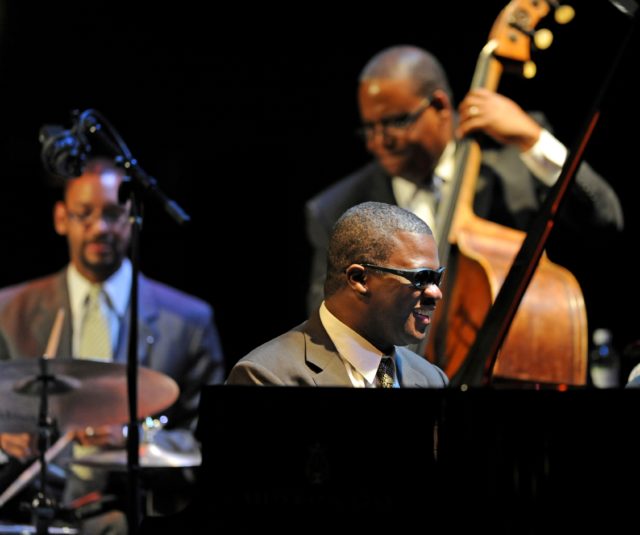
The Boulder Philharmonic Orchestra returns to Macky Auditorium on Saturday, January 22 (7:30 p.m.) for the first time in two years, with an all-Gershwin program.
Two works are featured: An American in Paris and the Piano Concerto in F, performed with the Marcus Roberts Trio: Roberts, piano, Rodney Jordan, bass, and Jason Marsalis, drums. The same program will be presented Sunday, January 23 at the Lone Tree Arts Center (1:30 p.m.). Tickets to both concerts, and for a live stream Saturday, are available through the Boulder Phil web page.
While an all-Gershwin program is a little unusual for a symphony orchestra, “this is a nice way to get back to Macky,” conductor Michael Butterman says. “A Gershwin celebration just feels festive.”
The Concerto harks back to a concert early in Butterman’s tenure with the orchestra, when Roberts and his trio played the Concerto in F. “I think it was my very first season,” Butterman says. “I remember that as one of the highlights of my time in Boulder, because it’s exciting to see the musicians of the orchestra so engaged.”
In fact, performing Gershwin—both the Concerto and Rhapsody in Blue—with his trio and full orchestra has become something of a specialty for Roberts, who has been blind since the age of 5 as a result of glaucoma and cataracts. He first performed Rhapsody in 1996, and then was encouraged by conductor Seiji Ozawa to take up the concerto. Roberts and his trio performed Rhapsody in Blue at the Colorado Music Festival with conductor Michael Christie in 2011.
When Roberts performs the Concerto, the orchestra plays almost entirely what Gershwin wrote. Sometimes Roberts is playing the solo piano part, either as Gershwin wrote it or with his own spin on the part. But other times, the orchestra drops out entirely to leave space for the trio to take over, much like solos in a jazz concert.
Like the jazz artist he is, Roberts never plays the solo sections the same twice. Butterman, who has performed the Concerto with the Roberts Trio three times before, says, “every time we played it with them, including in rehearsal, it’s a different piece. I’m just there like anybody else, enjoying the ride where you don’t know what’s around the next turn.”
It helps that Roberts studied classical piano with Leonidas Lipovetsky at Florida State University. “There are things that I take from classical pieces that I studied,” Roberts says. “When I improvise [with orchestra], it’s not like I change into a completely different approach as a pianist. It’s just that the influences that I draw upon become different. You still play your personality.”
Ozawa encouraged Roberts to take up other concertos, but so far he has stuck with Gershwin. “Ozawa always wanted me to do one of the Ravel concertos,” he says. “But the more I look over Ravel’s music, I think, what would you do to improve it?
“One of the reasons that Gershwin’s music is so popular in the jazz community is because his music has a real sensibility built into it. If you know what to do, it allows some really creative things that can happen, because his themes are very easy to catch.”
Roberts recalls that when he first performed Rhapsody in Blue with the orchestra, “I caught a lot of flack for daring to change the piano part.” But he notes that Gershwin himself improvised when he performed his pieces. “And like I told the critics,” he adds, “there are 300 other versions you can listen to. You don’t have to listen to mine!”
Roberts acknowledges the daunting challenges he faced performing with symphony orchestras. “Classical conductors are thinking, ‘Okay, people are looking at my baton, here’s a blind guy playing jazz. How’s this going to work?’ [Ozawa] helped a lot with that. I developed cues that were very clear so he would know, when I play this, we’re two measures before rehearsal No. 6—or something.”
Roberts is grateful to the conductors who were willing to take up the challenge. “Michael Butterman is one of the early conductors who believed in what I was trying to do in terms of bringing jazz and classical together,” he says. “He understands the importance of doing that, so he’s willing to program these things.”
He goes on to explain that an important goal is to bring the best qualities of classical and jazz together. “We want to make sure that [audiences] understand the grandeur and beauty and structural logic that classical music has, and the freedom of improvisation and spontaneity of jazz.
“Ravel loved jazz, and I think he said, if you can get 5 percent of that into his music, he would do it. That’s how I feel about classical music: If I can get 5 to 10 percent of it and exploit that, then I feel like I’m making a contribution.”














